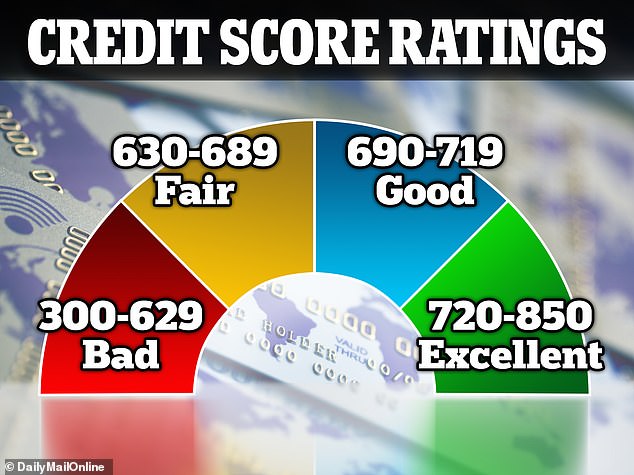Why your credit score has never been more important: Loan rejections are at record highs – here’s how you can boost your rating
It has become more difficult for Americans to take out a loan or get approved for a credit card as financial companies have tightened their credit standards.
According to the latest data from the New York Federal Reserve, the overall denial rate for all types of loans — including credit cards, auto loans and mortgages — had risen to nearly 22 percent by the end of June.
This is the highest level since June 2018, with those with a credit score below 680 being hit hardest, according to the data.
The rejection rate for car loans rose from 9.1 percent in February to 14.2 percent, a new record.
It also rose for credit cards, requests for credit card limit increases, mortgages and mortgage refinancing applications to 21.5 percent, 30.7 percent, 13.2 percent and 20.8 percent, respectively.
The overall rejection rate for all types of loans – including credit cards, car loans and mortgages – rose to almost 22 percent at the end of June – with the increase being greatest among those with a credit score below 680.
After a series of bank failures earlier this year and a series of inflation-busting rate hikes, lenders have less money to hand out, making them stricter and pickier with borrowers.
A Federal Reserve questionnaire of senior loan officers said in July: “In the second quarter, significant net shares of banks reported tightening standards for credit card and other consumer lending.”
Randall Watsek, financial advisor at investment bank Raymond James, said Money: ‘When you have less money, you focus on the best people you can find with the limited amount of resources you have.’
Experts warn this means it’s more important than ever to make sure you have a good credit score, as lenders are more likely to reject applications outright, raise minimum credit score requirements or charge higher interest.
Your FICO The score, which lenders and potential creditors such as landlords use to assess your ability to manage credit, can range between 300 and 850.
According to the credit scoring company, anything below 629 is considered “poor,” while anything above 720 is “excellent.”
Ted Rossman, senior industry analyst at Bank ratetold DailyMail.com that he would generally look at a score of 740 for qualifying for the best terms for most financial products – and a score of 780 for the best mortgage terms.
How to Increase Your Credit Score
To improve your score, he recommends you “pay your bills on time, keep your debt low, and demonstrate that you can successfully manage different types of credit over the long term.”
He highlighted how your score will have a substantial impact on the terms you can get on financial products.
For example, if you have a credit score of 675 and qualify for a $300,000 mortgage with a 30-year term and an interest rate of 7.646 percent, you’ll pay $2,128 per month, according to the latest figures from FICO.

According to credit scoring company FICO, anything below 629 is considered “poor,” while anything above 720 is “excellent.”

Ted Rossman, senior industry analyst at Bankrate, recommends demonstrating that you can successfully manage different types of credit over the long term to improve your score
However, if you have a score of 780 and qualify for a 30-year deal at 7.033 percent, you’ll pay $2,003 per month.
“Over 30 years, that’s a difference of $45,000, which is a good way to illustrate the importance of a good credit score,” he said.
He added that you should consider your credit utilization rate as a way to improve your score.
This is the credit you use divided by the credit available to you. This is especially important when it comes to credit cards and other revolving loans.
For example, if you have a $5,000 limit on a credit card and you charge $2,000 on it, your credit utilization rate is 40 percent.
“The use of credit is something you can change quite quickly,” Rossman said. ‘It’s usually on your statement, which a lot of people don’t know.
“Even if you pay the full amount each month and avoid interest, you can have a high utilization rate if you use the card a lot. Say you go on vacation or do some home improvements and you spend $4,000, you’ll have used up 80 percent of your credit that month. That looks risky.’
Financial experts typically recommend keeping your credit utilization rate under 30 percent, while FICO says most people with the best credit scores keep it under 10 percent, according to Rossman.
‘My advice would be to make one or two extra payments mid-month, or perhaps ask for a higher credit limit. These are both ways in which you can reduce this ratio.’
Many major credit card companies and some auto loan companies have started reporting credit scores on your monthly statement.
Otherwise, you can access your score through an online credit scoring service or purchase it directly from one of the credit reporting companies, including FICO.
Keep in mind that while some credit scoring services advertise a “free” score, you may need to sign up for a credit monitoring service with a monthly subscription fee.
According to Experian, the average American has a credit score of 714 – although this varies from state to state.
